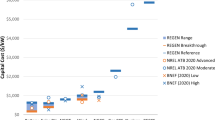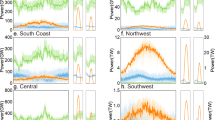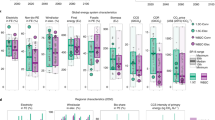Abstract
Carbon capture and storage (CCS) for fossil-fuel power plants is perceived as a critical technology for climate mitigation. Nevertheless, limited installed capacity to date raises concerns about the ability of CCS to scale sufficiently. Conversely, scalable renewable electricity installations—solar and wind—are already deployed at scale and have demonstrated a rapid expansion potential. Here we show that power-sector CO2 emission reductions accomplished by investing in renewable technologies generally provide a better energetic return than CCS. We estimate the electrical energy return on energy invested ratio of CCS projects, accounting for their operational and infrastructural energy penalties, to range between 6.6:1 and 21.3:1 for 90% capture ratio and 85% capacity factor. These values compare unfavourably with dispatchable scalable renewable electricity with storage, which ranges from 9:1 to 30+:1 under realistic configurations. Therefore, renewables plus storage provide a more energetically effective approach to climate mitigation than constructing CCS fossil-fuel power stations.
This is a preview of subscription content, access via your institution
Access options
Access Nature and 54 other Nature Portfolio journals
Get Nature+, our best-value online-access subscription
$29.99 / 30 days
cancel any time
Subscribe to this journal
Receive 12 digital issues and online access to articles
$119.00 per year
only $9.92 per issue
Buy this article
- Purchase on Springer Link
- Instant access to full article PDF
Prices may be subject to local taxes which are calculated during checkout




Similar content being viewed by others
Data availability
All data used in this analysis were based on published studies that are duly referenced in the text and the related tables. Any assumptions, adjustments and normalizations are described in the captions or the text. The annotated code used to run the analysis and develop the figures can be openly accessed on Github (http://nbviewer.jupyter.org/github/csaladenes/sustainable-energy-transitions/blob/master/ccs/eroei-ccs-workbook.ipynb). The corresponding author will make available any additional information upon reasonable request.
References
Technology Roadmap: Carbon Capture and Storage (International Energy Agency, 2013).
van Vuuren, D. P. et al. Carbon budgets and energy transition pathways. Environ. Res. Lett. 11, 1–12 (2016).
Koelbl, B. S., van den Broek, M. A., Faaij, A. P. C. & van Vuuren, D. P. Uncertainty in carbon capture and storage (CCS) deployment projections: a cross-model comparison exercise. Climatic Change 123, 461–476 (2014).
Bui, M. et al. Carbon capture and storage (CCS): the way forward. Energy Environ. Sci. 3, 1–115 (2018).
Kaya, A., Csala, D. & Sgouridis, S. Constant elasticity of substitution functions for energy modeling in general equilibrium integrated assessment models: a critical review and recommendations. Climatic Change 43, 225–214 (2017).
CSI Carbon Capture and Sequestration Project Database (MIT, 2017); https://sequestration.mit.edu/
Roadmap for Carbon Capture and Storage Demonstration and Deployment in the People’s Republic of China (Asian Development Bank, 2015).
Renewables 2016 Global Status Report (Renewable Energy Policy Network for the 21st Century, 2016).
Reiner, D. M. Learning through a portfolio of carbon capture and storage demonstration projects. Nat. Energy 1, 15011–15017 (2016).
Sanchez, D. L. & Kammen, D. M. A commercialization strategy for carbon-negative energy. Nat. Energy 1, 15002–15004 (2016).
Murphy, D. J. & Hall, C. A. S. Year in review—EROI or energy return on (energy) invested. Ann. NY Acad. Sci. 1185, 102–118 (2010).
Murphy, D. J., Hall, C. A. S., Dale, M. & Cleveland, C. Order from chaos: a preliminary protocol for determining the EROI of fuels. Sustainability 3, 1888–1907 (2011).
Carbajales-Dale, M., Barnhart, C. J., Brandt, A. R. & Benson, S. M. A better currency for investing in a sustainable future. Nat. Clim. Change 4, 524–527 (2014).
Sgouridis, S., Csala, D. & Bardi, U. The sower’s way: quantifying the narrowing net-energy pathways to a global energy transition. Environ. Res. Lett. 11, 1–8 (2016).
Sathre, R., Chester, M., Cain, J. & Masanet, E. A framework for environmental assessment of CO2 capture and storage systems. Energy 37, 540–548 (2012).
Modahl, I. S., Askham, C., Lyng, K.-A. & Brekke, A. Weighting of environmental trade-offs in CCS—an LCA case study of electricity from a fossil gas power plant with postcombustion CO2 capture, transport and storage. Int. J. Life Cycle Assess. 17, 932–943 (2012).
Corsten, M., Ramirez, A., Shen, L., Koornneef, J. & Faaij, A. Environmental impact assessment of CCS chains—lessons learned and limitations from LCA literature. Int. J. Greenh. Gas Control 13, 59–71 (2013).
Kong, Y. et al. EROI analysis for direct coal liquefaction without and with CCS: the case of the Shenhua DCL project in China. Energies 8, 786–807 (2015).
Viebahn, P. et al. Comparison of carbon capture and storage with renewable energy technologies regarding structural, economic, and ecological aspects in Germany. Int. J. Greenh. Gas Control 1, 121–133 (2007).
King, L. C. & van den Bergh, J. C. J. M. Implications of net energy-return-on-investment for a low-carbon energy transition. Nat. Energy 3, 334–340 (2018).
Khalilpour, R. & Abbas, A. HEN optimization for efficient retrofitting of coal-fired power plants with postcombustion carbon capture. Int. J. Greenh. Gas Control 5, 189–199 (2011).
Schreiber, A., Zapp, P. & Marx, J. Meta-analysis of life cycle assessment studies on electricity generation with carbon capture and storage. J. Ind. Ecol. 16, S155–S168 (2012).
Matthews, H. S. & Small, M. J. Extending the boundaries of life‐cycle assessment through environmental economic input–output models. J. Ind. Ecol. 4, 7–10 (2000).
Boot-Handford, M. E. et al. Carbon capture and storage update. Energy Environ. Sci. 7, 130–189 (2014).
House, K. Z., Harvey, C. F., Aziz, M. J. & Schrag, D. P. The energy penalty of postcombustion CO2 capture & storage and its implications for retrofitting the U.S. installed base. Energy Environ. Sci. 2, 193 (2009).
Cost and Performance Comparison Baseline for Fossil Energy Power Plants (National Energy Technology Laboratory, 2013).
Sanpasertparnich, T., Idem, R., Bolea, I., deMontigny, D. & Tontiwachwuthikul, P. Integration of postcombustion capture and storage into a pulverized coal-fired power plant. Int. J. Greenh. Gas Control 4, 499–510 (2010).
Abu-Zahra, M. R. M., Schneiders, L. H. J., Niederer, J. P. M., Feron, P. H. M. & Versteeg, G. F. CO2 capture from power plants. Int. J. Greenh. Gas Control 1, 37–46 (2007).
El-Suleiman, A., Anosike, N. & Pilidis, P. A preliminary assessment of the initial compression power requirement in CO2 pipeline ‘carbon capture and storage (CCS) technologies’. Technologies 4, 15–19 (2016).
Apostoleris, H., Sgouridis, S., Stefancich, M. & Chiesa, M. Evaluating the factors that led to low-priced solar electricity projects in the Middle East. Nat. Energy 3, 1109–1114 (2018).
Bhandari, K. P., Collier, J. M., Ellingson, R. J. & Apul, D. S. Energy payback time (EPBT) and energy return on energy invested (EROI) of solar photovoltaic systems: a systematic review and meta-analysis. Renew. Sustain. Energ. Rev. 47, 133–141 (2015).
Leccisi, E., Raugei, M. & Fthenakis, V. The energy and environmental performance of ground-mounted photovoltaic systems—a timely update. Energies 9, 622–13 (2016).
Raugei, M. et al. Energy return on energy invested (ERoEI) for photovoltaic solar systems in regions of moderate insolation—a comprehensive response. Energy Policy 102, 377–384 (2017).
Koppelaar, R. H. E. M. Solar-PV energy payback and net energy: meta-assessment of study quality, reproducibility, and results harmonization. Renew. Sustain. Energy Rev. 72, 1241–1255 (2016).
Görig, M. & Breyer, C. Energy learning curves of PV systems. Environ. Prog. Sustain. Energy 35, 914–923 (2016).
Davidsson, S., Höök, M. & Wall, G. A review of life cycle assessments on wind energy systems. Int. J. Life Cycle Assess. 17, 729–742 (2012).
Dale, M. A comparative analysis of energy costs of photovoltaic, solar thermal, and wind electricity generation technologies. Appl. Sci. 3, 325–337 (2013).
Kubiszewski, I., Cleveland, C. J. & Endres, P. K. Meta-analysis of net energy return for wind power systems. Renew. Energy 35, 218–225 (2010).
Dupont, E., Koppelaar, R. & Jeanmart, H. Global available wind energy with physical and energy return on investment constraints. Appl. Energy 209, 322–338 (2017).
Hirth, L., Ueckerdt, F. & Edenhofer, O. Integration costs revisited—an economic framework for wind and solar variability. Renew. Energy 74, 925–939 (2015).
Jaehnert, S., Wolfgang, O., Farahmand, H., Völler, S. & Huertas-Hernando, D. Transmission expansion planning in Northern Europe in 2030—methodology and analyses. Energy Policy 61, 125–139 (2013).
Jacobsen, H. K. & Schröder, S. T. Curtailment of renewable generation economic optimality and incentives. Energy Policy 49, 663–675 (2012).
Ueckerdt, F., Brecha, R. & Luderer, G. Analyzing major challenges of wind and solar variability in power systems. Renew. Energy 81, 1–10 (2015).
Frew, B. A., Becker, S., Dvorak, M. J., Andresen, G. B. & Jacobson, M. Z. Flexibility mechanisms and pathways to a highly renewable US electricity future. Energy 101, 65–78 (2016).
Gils, H. C., Scholz, Y., Pregger, T., de Tena, D. L. & Heide, D. Integrated modelling of variable renewable energy-based power supply in Europe. Energy 123, 173–188 (2017).
Barnhart, C. J., Dale, M., Brandt, A. R. & Benson, S. M. The energetic implications of curtailing versus storing solar- and wind-generated electricity. Energy Environ. Sci. 6, 2804 (2013).
Koller, M., Borsche, T., Ulbig, A. & Andersson, G. Review of grid applications with the Zurich 1 MW battery energy storage system. Electr. Power Syst. Res. 120, 128–135 (2015).
Blanco, H. & Faaij, A. A review at the role of storage in energy systems with a focus on Power to Gas and long-term storage. Renew. Sust. Energy Rev. 81, 1049–1086 (2018).
Breyer, C. et al. On the role of solar photovoltaics in global energy transition scenarios. Prog. Photovolt. 25, 727–745 (2017).
Hagens, N. J. & Mulder, K. in Biofuels, Solar and Wind as Renewable Energy Systems: Benefits and Risks (ed. Pimentel, D.) Ch. 12, 295–319 (Springer, 2008).
Zhang, Y. & Colosi, L. M. Practical ambiguities during calculation of energy ratios and their impacts on life cycle assessment calculations. Energy Policy 57, 630–633 (2013).
Metz, B., Davidson, O., De Coninck, H., Loos, M. & Meyer, L. IPCC Special Report on Carbon Dioxide Capture and Storage (Cambridge Univ. Press, 2005).
Mokhtar, M. et al. Solar-assisted post-combustion carbon capture feasibility study. Appl. Energy 92, 668–676 (2012).
Harkin, T., Hoadley, A. & Hooper, B. Reducing the energy penalty of CO2 capture and compression using pinch analysis. J. Clean. Prod. 18, 857–866 (2010).
EIO-LCA: Free, Fast, Easy Life Cycle Assessment (Carnegie Mellon University, Green Design Institute, accessed 5 June 2018); www.eiolca.net.
Producer Price Index (PPI) (Bureau of Labor Statistics, accessed 5 June 2018); https://www.bls.gov/ppi/
Knoope, M. M. J., Ramírez, A. & Faaij, A. P. C. A state-of-the-art review of techno-economic models predicting the costs of CO2 pipeline transport. Int. J. Greenh. Gas Control 16, 241–270 (2013).
Chandel, M. K., Pratson, L. F. & Williams, E. Potential economies of scale in CO2 transport through use of a trunk pipeline. Energy Convers. Manage. 51, 2825–2834 (2010).
Kolster, C., Mechleri, E., Krevor, S. & Mac Dowell, N. The role of CO2 purification and transport networks in carbon capture and storage cost reduction. Int. J. Greenh. Gas Control 58, 127–141 (2017).
Knoope, M. M. J., Ramírez, A. & Faaij, A. P. C. The influence of uncertainty in the development of a CO2 infrastructure network. Appl. Energy 158, 332–347 (2015).
Mechleri, E., Brown, S., Fennell, P. S. & Mac Dowell, N. CO2 capture and storage (CCS) cost reduction via infrastructure right-sizing. Chem. Eng. Res. Des. 119, 130–139 (2017).
Raugei, M. Net energy analysis must not compare apples and oranges. Nat. Energy 4, 86–88 (2019).
Freise, J. The EROI of conventional Canadian natural gas production. Sustainability 3, 2080–2104 (2011).
Sell, B., Murphy, D. & Hall, C. A. S. Energy return on energy invested for tight gas wells in the Appalachian Basin, United States of America. Sustainability 3, 1986–2008 (2011).
Yaritani, H. & Matsushima, J. Analysis of the energy balance of shale gas development. Energies 7, 2207–2227 (2014).
Poisson, A. & Hall, C. Time series EROI for Canadian oil and gas. Energies 6, 5940–5959 (2013).
Hu, Y., Hall, C. A. S., Wang, J., Feng, L. & Poisson, A. Energy return on investment (EROI) of China. Energy 54, 352–364 (2013).
Hall, C. A. S., Lambert, J. G. & Balogh, S. B. EROI of different fuels and the implications for society. Energy Policy 64, 141–152 (2014).
Barnhart, C. J. & Benson, S. M. On the importance of reducing the energetic and material demands of electrical energy storage. Energy Environ. Sci. 6, 1083–10 (2013).
Wendel, C. H., Kazempoor, P. & Braun, R. J. Novel electrical energy storage system based on reversible solid oxide cells: system design and operating conditions. J. Power Sources 276, 133–144 (2015).
Pellow, M. A., Emmott, C. J. M., Barnhart, C. J. & Benson, S. M. Hydrogen or batteries for grid storage? A net energy analysis. Energy Environ. Sci. 8, 1938–1952 (2015).
Acknowledgements
We thank the organizers and participants of the ECI CO2 Summit for their comments and discussion, and especially J. Wilcox and N. McDowell for their feedback on the original idea. We also thank Masdar Institute for supporting our participation. M.C. acknowledges the support of the Arctic Center for Sustainable Energy (ARC), UiT Arctic University of Norway through grant no. 310059.
Author information
Authors and Affiliations
Contributions
S.S. conceived the research idea, conducted the initial analysis, collected data and authored the majority of the text. M.C.-D. authored parts of the text, reviewed the analysis, proposed changes and contributed to data collection. D.C. developed the sensitivity analysis models and the code for the figures, and checked and contributed to the analysis. U.B. reviewed and edited the manuscript and contributed parts of the text. M.C. reviewed and edited the manuscript and proposed changes for its organization and structure.
Corresponding author
Ethics declarations
Competing interests
The authors declare no competing interests.
Additional information
Publisher’s note: Springer Nature remains neutral with regard to jurisdictional claims in published maps and institutional affiliations.
Supplementary information
Supplementary Information
Supplementary Tables 1–5, Supplementary Note, Supplementary Figs. 1–3, Supplementary References
Rights and permissions
About this article
Cite this article
Sgouridis, S., Carbajales-Dale, M., Csala, D. et al. Comparative net energy analysis of renewable electricity and carbon capture and storage. Nat Energy 4, 456–465 (2019). https://doi.org/10.1038/s41560-019-0365-7
Received:
Accepted:
Published:
Issue Date:
DOI: https://doi.org/10.1038/s41560-019-0365-7
This article is cited by
-
Systemwide energy return on investment in a sustainable transition towards net zero power systems
Nature Communications (2024)
-
Carbon–neutral hydrogen production by catalytic methane decomposition: a review
Environmental Chemistry Letters (2024)
-
A net-zero emissions strategy for China’s power sector using carbon-capture utilization and storage
Nature Communications (2023)
-
Reduction potential of the energy penalty for CO2 capture in CCS
Frontiers in Energy (2023)
-
Research progress and the prospect of CO2 hydrogenation with dielectric barrier discharge plasma technology
Carbon Letters (2023)



